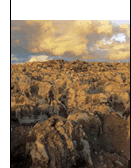|
Paradise
for Sale
Page
3
Worrisome
Environmental Indicators
BIODIVERSITY
The loss of biodiversity is speeding up to a rate that is found
in mass extinctions—human behavior caused 20 percent of all
birds to become extinct in the past 2,000 years. An equal percentage
is now threatened, endangered, or missing.
CLIMATE
Carbon dioxide concentration in the atmosphere has increased 30
percent in the past 100 years. The decade of the 1990s was the hottest
on record.
POPULATION
The number of people is 100 times greater than any similar-sized,
non-domesticated animal in the history of the world—an ecological
abnormality.
CONSUMPTION
If the consumption level of all 6.2 billion people on Earth equaled
that of North Americans, then at least two more earths would be
required to maintain that level without degrading life-support capacity.
POLLUTION
Every section of land and water on Earth is contaminated with human-synthesized
chlorinated hydrocarbons with mild to extreme toxicities. Many of
the thousands of toxic waste sites in the United States are in areas
inhabited by minorities and the poor.
AGRICULTURE
Rates of soil erosion in the United States are higher than they
were during the dust bowl era of the 1930s. The global loss of cropland
to soil exhaustion, erosion, salinization, and waterlogging is 4
percent per decade.
WATER
Human activities use over half of the readily available freshwater.
The Ogallala aquifer under the Great Plains of the United States,
like many other aquifers, is being depleted much faster than it
is being recharged.
What
We Can Do to Erase the Human Footprint
EDUCATION
Know what humans have done and are doing to the earth, as well
as how we might change these destructive patterns.
CHILDREN
Reduce population and consumption--by about half--by having
just one or two children later in life. Make family planning available
to everybody, everywhere.
CONSUMPTION
Bike, walk, and ride public transportation; support legislation
for high gas mileage vehicles; buy energy-efficient light bulbs,
appliances, cars, and houses; replace air conditioning with fans;
keep inside temperatures high in summer (75 degrees) and low in
winter (65 degrees) and use night set-back thermostats; support
renewable energy (solar, wind, geothermal) and building codes for
energy-efficient structures; compost; recycle toxics, glass, metal,
plastic, and paper; share yard equipment with a neighbor.
FOOD
Plant a garden, buy food locally, participate in community-supported
agriculture, eat less meat, support measures to promote organic
farming and preserve farmland.
BIODIVERSITY
Adopt some patch of biodiversity (a vacant lot, a bit of woods,
part of a stream) to learn about and protect; support programs that
expose people to nature; arrest sprawl and only develop areas already
exploited; restore natural habitats; keep wilderness and other areas
free of roads; maintain old-growth forests; protect endangered species
and their habitats.
Reading
List for More Information
More
information on the Nauru experiment and its connections to the global
experiment underway can be found in Paradise for Sale: A Parable
of Nature, Carl N. McDaniel and John M. Gowdy, University of
California Press, 2000. A sobering discussion of the human capacity
for fantasy is found in The Spirit in the Gene: Humanity's Proud
Illusion and the Laws of Nature, Reg Morrison, Cornell University
Press, 1999. An excellent and well-written account of the biology
of biodiversity can be found in The Diversity of Life, Edward
O. Wilson, Belknap Press of Harvard University Press, 1992. The
status of biodiversity and proposals for its salvation are considered
in The Future of Life, Edward O. Wilson, Knopf, 2002. A thorough
assessment of biodiversity in the United States is provided in Our
Precious Heritage, Bruce A. Stein, Lynn S. Kutner, and Jonathan
S. Adams (eds), Oxford University Press, 2000. A summary of Earth
history from an environmental perspective is given in A Green
History of the World, Clive Ponting, Penguin Books, 1991. An
environmental history of the 20th century is given in Something
New Under the Sun, J.R. McNeill, Norton, 2000.
Oberlin
Environmental Education Alumni Association (OEEAA)
A group
of alumni has organized a new affiliate group, OEEAA, that is now
seeking members. If you have interest in supporting environmental
education in the Oberlin community, on or off campus, please contact
the Alumni Association at (440) 775-8692 for more information.
Go
To Page 1 | 2 | 3
of Paradise for Sale
|


